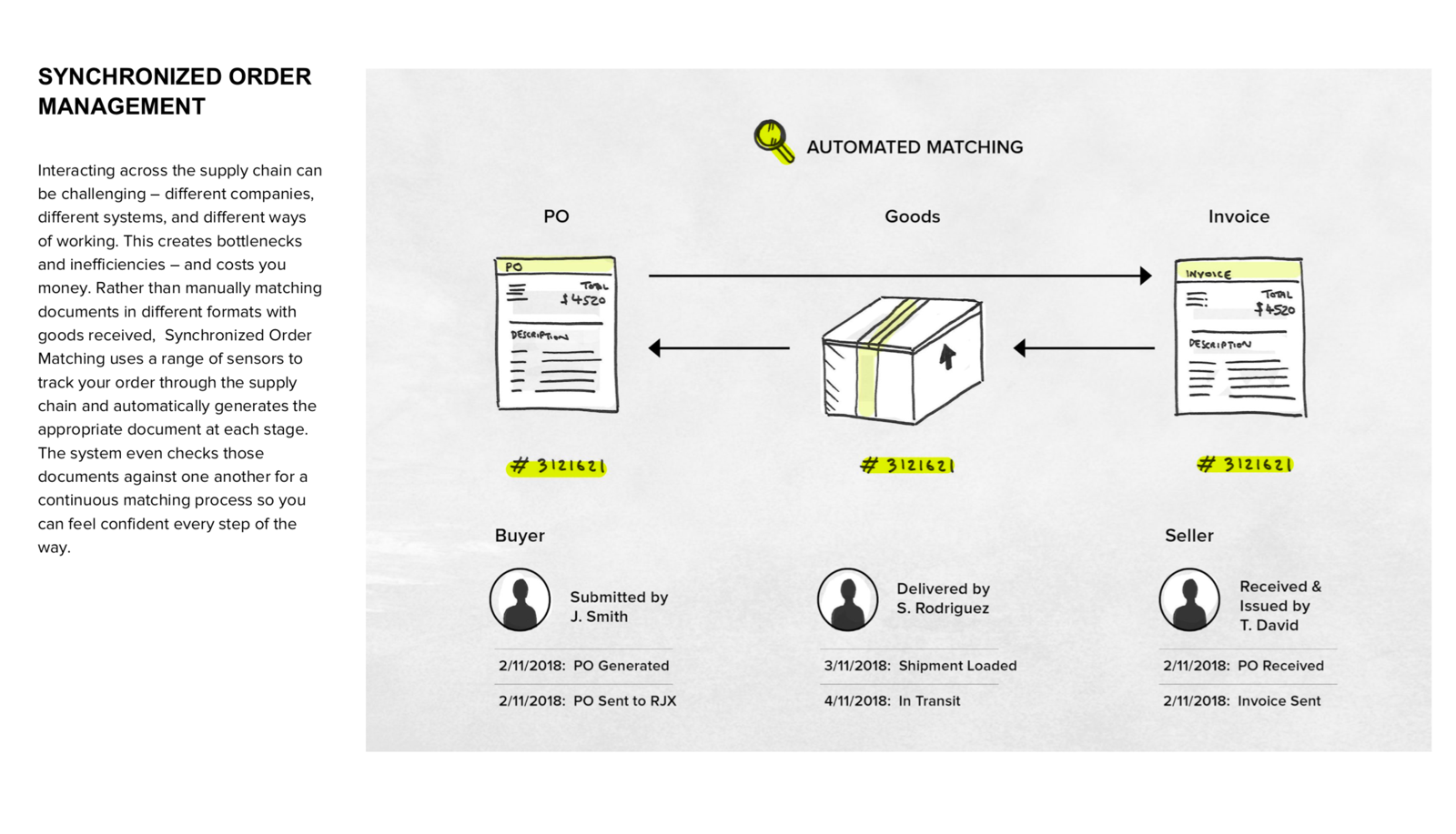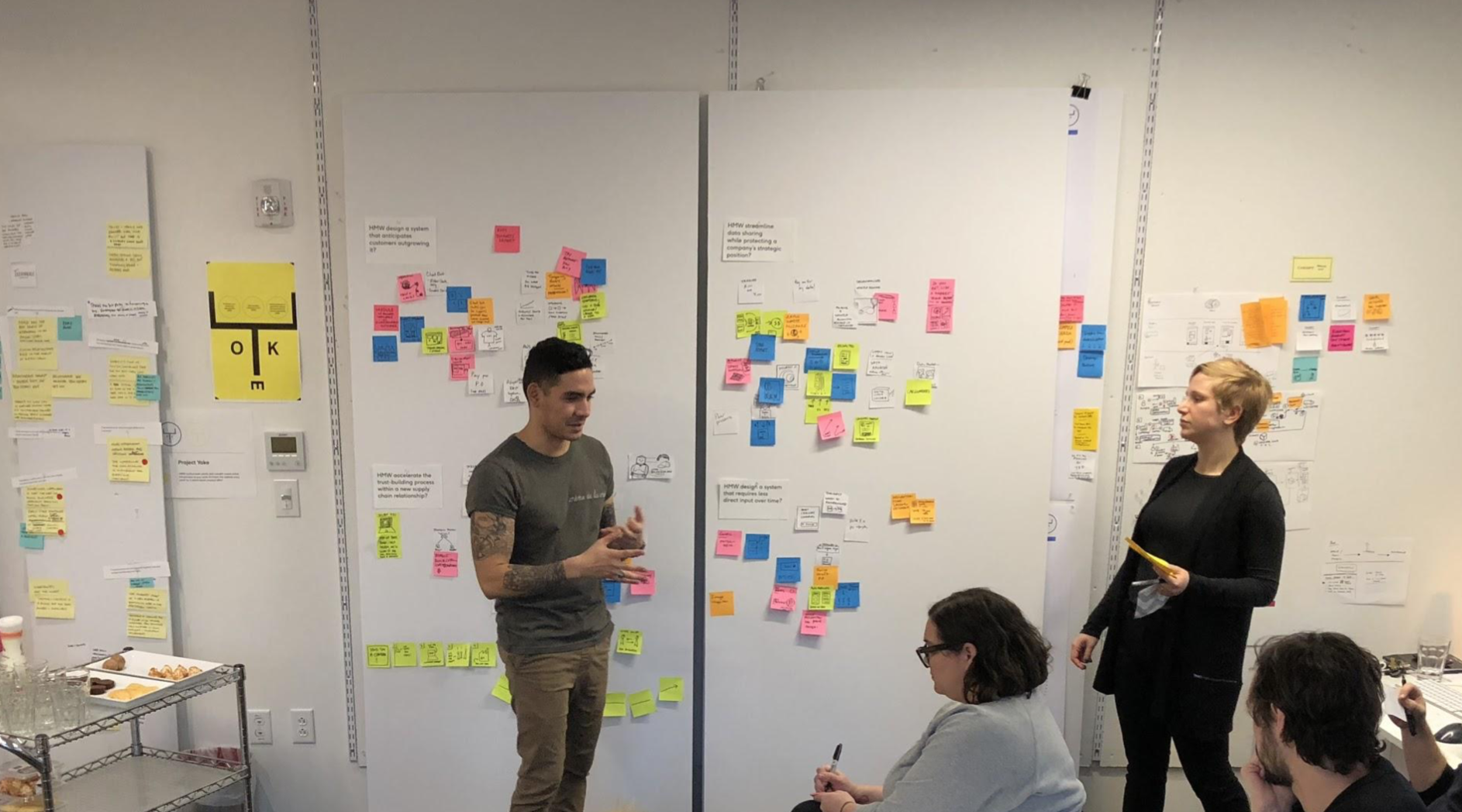IDEO
User Research & Design Opportunities
How might we create a compelling blockchain-enabled order management solution for SMEs?

Overview
In partnership with IDEO, we set out to better understand the needs of potential SME customers in the supply chain financing, logistics and order management space, and to surface opportunity areas for the development of a proof of concept application on the Eximchain network that addresses those needs.
What we found were rapidly growing organizations navigating hacked together systems and struggling to support their rapid growth and manage their evolving risks. After synthesizing our research we generated four opportunity areas with preliminary solutions and five design principles to guide the next stage of product design and validation.
Role
Product Designer
User Research, Storyboards & Journey Maps, Low Fidelity Mockups, Prototyping & Testing
Team
Owen Sanderson, Hannah Rosenfeld, Tom Kershaw
Timeframe
October 2018 - December 2018 • 6 wks

Planning & Objective
Timeline
As the as the product design manager at Eximchain I coordinated all user research initiatives with IDEO to find unseen opportunities for innovation. I transitioned to working full-time in the IDEO Cambridge office to take advantage of the research process and learn as much as I could.

Looking In Interviews
We used looking in interviews to better understand Eximchain today, the company’s goals for the future and how our work is positioned within this roadmap through the spective of each company lead. In addition, these conversations helped the IDEO team get to know the Eximchain team as people and professionals, and better understand what project success looks like from our unique perspectives.

How Might We…
The IDEO team taught me a unique form of note taking called “How Might We...” (HMW) to use as a tool before we began the interview process. The phrase creates an open environment for new ideas, optimistically admits we don’t have a solution, and encourages a collaborative approach to generating a solution.

Research Objective
After completing all the internal looking in interviews we crafted a HWM to lead us into our looking out interviews. HMW identify potential customers, understand their needs, and create a compelling blockchain-enabled order management solution?
User Research
Looking Out Interviews
After creating multiple interface applications for our early customers it became apparent that common design patterns where forming. I created app templates that were easily customizable, which allowed new customers to a faster time-to-value. These templates are now part of the Tulip App Library.
We conducted thirteen interviews in three cities (Boston, MA, Portland, MN, and New York, NY), across eight industries.


Sacrificial Concepts
We created nine sacrificial concepts to present and gather feedback, lead two generative exercises and validated sixteen value props.

Sacrificial concepts are simple one page self explanatory, annotated sketches of possible solutions. We generated six initial sacrificial concepts to test and iterated on them after each interview. As we learned more about the procure to pay process we created an additional three concepts.

These concepts a great way to quickly gather feedback on new product ideas without having to create a full prototype or focus on specific elements of an interface.

Collaborative Mapping
We ask users to map their existing supply chains using the cards provided. We then had them draw over their map on acetate to indicate what their ideal supply chain might look like. This helped us understand both their current realities as well as the more desirable state we’re designing towards.

To recreate this exercise create a large blank board with the first step of your process on the left and the end goal on the right. Create different colored cards or tiles labeled with actions (blue), tools (orange), and tools (white) along with some blank cards for the user to write in anything that isn’t present. After the user maps their process walks you through it as it currently is, overlay the board with clear acetate. Then ask the user to write over the map with their ideal flow.

User Journey Map
After all our interviews we created a simplified procure to pay user journey to help ground our following synthesis and brainstorming sessions.

Synthesis
The synthesis phase is a key event and just as important as conducting interviews well. The goal of the synthesis is to organize learning into themes, translate observations into insights, consider strategic frameworks, articulate opportunity areas, and finally brainstorm features and concepts.
Articulating Emerging Themes into Insights
To elevate our learning into themes, we retold each story from research aloud, voted on top takeaways and organized them into higher level patterns and themes. These themes were utilized to inspire insights. We organized our themes in interesting ways, arriving at a first draft of insights that express a point of view and can inspire design moving forward.

Crafting Value Propositions
We reframed our insights as pain points and clustered them across stakeholders. We then articulated value propositions against each to test in an online survey.
Considering Strategic Frameworks
We also crafted a strategic framework to organize our learning from research and point towards compelling opportunities for design.
Brainstorming Ideas
With our insights as a guide, we crafted questions to use in a brainstorm session to arrive at concept sketches. After a final brainstorming session we finalized our research insights, outlined distinct design opportunity areas and surfaced product features.

Opportunities
We created nine insights from our research synthesis. Three in each category of technology, finance and collaboration. The key deliverables from the project were opportunity areas for design to give a targeted focus for the next design phase.
Considering Desirability, Viability and Feasibility
Truly innovative solutions require a balance of desirability, feasibility and viability. IDEO’s process focused on understanding what is desirable from a human point of view, and considering how those needs might inform design solutions that represent viable opportunities moving forward. While we have taken into account the unique constraints and capabilities of blockchain technology, further work will need to be done to translate these opportunity areas into technically feasible solutions in the product design and validation phase.

Opportunity Areas
Each opportunity area was mapped onto your strategic framework, included direct quotes from our users to support them, included value props for internal, external and inter-organizational systems, and proposed various business models.

We viewed where the opportunities overlapped the most on our strategic framework and choose two of the four to move forward with.

Design Principles
Design principles are learnings made actionable. They are evocative statements that translate learnings from research into design, with implications across all disciplines - from product development to service design. Design principles should be both generative - inspiring design solution - as well as evaluative, providing guardrails to evaluate ideas against.
We connected each design principle to our previous insights, and listed potential features that reflect these principles. With a clearer understanding of our users biggest pain points and the best opportunity areas to solve those problems, we were much better equipped to innovate and build new applications of blockchain technology for supply chains.

Reflection
This experience was a deep dive into human-centered user research, more thorough than I had ever learned in my schooling as a product designer. With short design sprints as a staple of my design process, I now also have the tools and frameworks to lead longer research, ideation and brainstorming session. This opportunity has taught me how to be a better listener and observer, allowing me to more easily understand my users and create design solutions that are backed by solid qualitative research.
